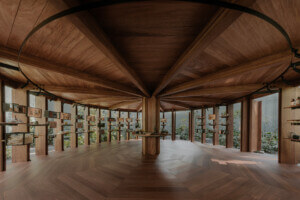In the world of shopping mall design, Victor Gruen’s name reigns supreme. The Austrian-born architect and urban planner is responsible for many early suburban shopping malls, which, believe it or not, were originally envisioned as pedestrian oases bustling with musical events, art, and civic functions. Gruen pioneered the typology, creating both the first open-air and the first fully enclosed suburban malls—the Northland Mall in Southfield, Michigan, and the Southdale Mall in Edina, Minnesota. Not one to be limited by geography, Gruen also built similar complexes across the rest of the country.
Though Gruen’s early works were originally designed for the automobile age, many have persisted and today are facing radical change. Converging trends in e-commerce and urbanization have lead to the increasing obsolescence of suburban shopping malls, the so-called “death of retail.” Of the malls that remain, several— like the Southdale Mall—are currently undergoing renovations to suit modern times.
Gruen Associates, 70 years after its initial founding, is working on several suburban mall adaptive reuse projects. The Architect’s Newspaper’s West Coast editor Antonio Pacheco spoke to several of the firm’s designers—Ashok Vanmali, partner; Devon Barnes, principal associate; Matthew Parrent, senior associate; and Orlando Gonzalez, associate— to investigate how the “death of retail” is affecting suburban shopping mall design.
The Architect’s Newspaper: What does your team make of the so-called “death of retail?”
Devon Barnes: It’s not that that there’s less desire for consuming goods; there’s just much less interest in static places. Between a traditional shop on 5th Avenue and a pop-up on the High Line, for a loose example, the latter may be more successful right now. Why? Because it’s a temporary, unique, experience-based, and placeand location-driven.
Ashok Vanmali: Victor Gruen’s early malls were conceived to be hubs of larger communities. People going to the mall were not simply going somewhere to buy something, rather they wanted to have an experience where they could connect with others—and also shop. In my opinion, a problem that developed over the years was that shopping became only about buying things and less about the experience of being in a particular place.
Orlando Gonzalez: Let’s remember: A lot of Gruen’s early works also included varied spaces for concerts, public functions, and temporary programmed activities. A lot of these functions, however, were stripped away over time for cost reasons. The public gathering spaces Victor Gruen originally envisioned were reduced to walking corridors and food courts in favor of more leasable space. It has not been so much the “death of retail” as it has been the neglect of public amenity space, and the condition of it, which married the pedestrian to the retail environment.
AN: What are some of the other aspects of design Gruen Associates is focusing on in recent retail-oriented projects?
Barnes: We’ve seen a strong shift toward fewer of the carbon-copy stores that brands used to depend on to maintain their image. Now retailers are taking a more site-specific approach to their “brand-itecture”—selling the goods in a space that is unique to that city. In many cities, retailers are taking over historic buildings in lieu of a leased spot in the mall to give their stores a sense of authenticity.
Vanmali: The luxury retailers we work with focus on the experience and on ambiance— how comfortable the spaces are, how clients are served. For example, one of our strategies revolved around making the shop look more like a home than a store with elements like fireplaces, lounge seating, and artwork. That way, the customer doesn’t necessarily feel like they’re shopping.
AN: A lot of the malls today are [also] converting shopping areas into food-focused hubs. People go out to eat and then shopping follows.
Gonzalez: They’re re-creating public gathering spaces, as Victor Gruen emphasized early on. He wanted to bring the public open space he experienced in his native Vienna to the new public gathering spaces of the United States. These spaces were designed to catalyze interaction, collaboration, and socio-economic progress. These principles are very much in line with how we design similar types of projects today.
AN: So do you see current contemporary trends as moving back toward that previous pattern?
Vanmali: Somewhat, but it’s not really “going back,” it is more like recapturing some of the original ideas and excitement that malls once brought. I don’t think today’s technology-driven lifestyles fit into those old models exactly. It’s evolving.
Matthew Parrent: There are a lot of aspects, however, that are similar. The intention with the Northland and Southland Malls in Michigan— some of the first malls we built in the 1950s— was to make the mall a town center. There would be a postoffice, a medical center, and housing.
Barnes: The suburban mall revolved around the family car. Now we have smartphones— and live in urban hubs with better public transportation. I’d say “evolving” is a good word to describe that process.
Parrent: The thread to today is there from those initial malls—people want public experiences, they want to gather, and they still want to shop. Shopping is not going to die.
AN: Right, retailers aren’t necessarily losing money—it’s just coming from different places.
Barnes: We, as architects, are excited about how brands are dramatically reinventing themselves right now. It gives us more room for creativity and our clients new options for generating revenue.
Vanmali: Luxury retailers have always had to periodically reinvent themselves. Most retailers in malls sign five to ten-year leases, and, at the end of those leases, they go back and renovate the spaces with new concepts. Now that products are more accessible via the internet, the physical manifestation of a brand has to be even more special.
AN: So, are malls going to have to reinvent themselves?
Vanmali: Definitely, they are going to have to reinvent themselves for the communities they serve.
Parrent: We can see those existing malls transforming already. We have had several projects where we have proposed to insert a variety of uses onto former parking lots to create more holistic developments. People want to shop in places that have some history. We worked on a conceptual master plan for the Southern California Association of Governments in Cerritos, California, recently, where we proposed creating a walkable regional transportation hub on a mall parking lot.
Gonzalez: And in that project, we took supersized parking lots that are 800 or 900 feet wide and broke them up to be human scaled, walkable blocks that are 300 to 500 feet long. We are designing these types of projects with a mix of uses and multimodal streetscapes. The healthy integration of streets, blocks, and buildings at a human scale is a basic ingredient of any livable community. These ingredients have never really changed, only how we as designers have composed them.










